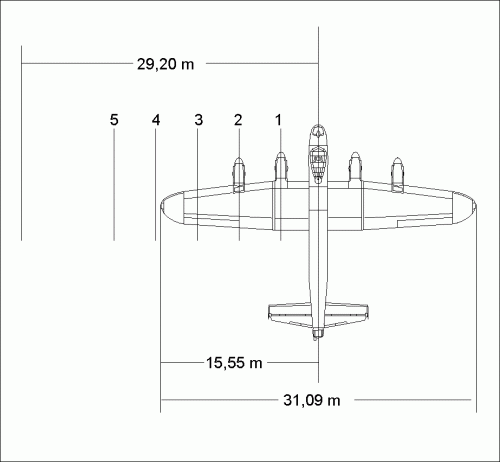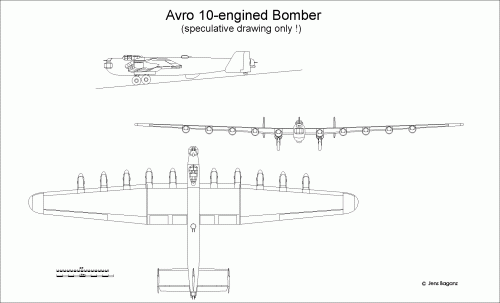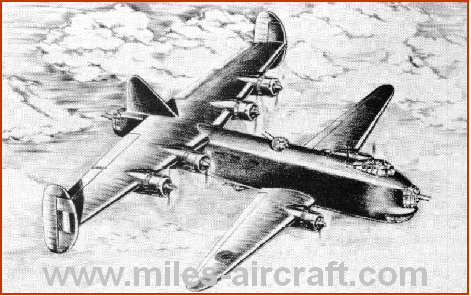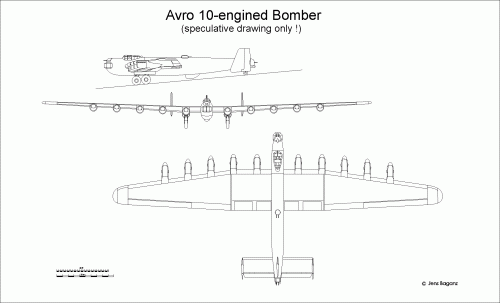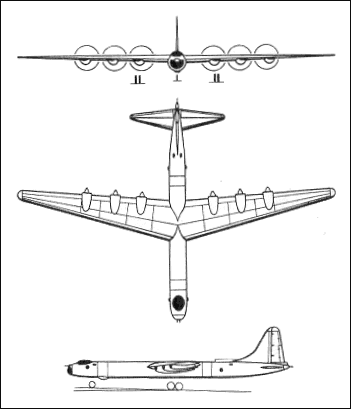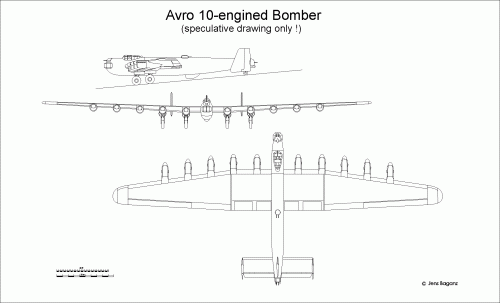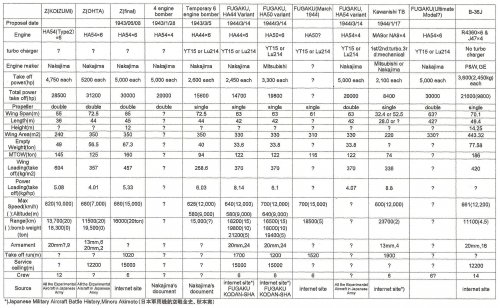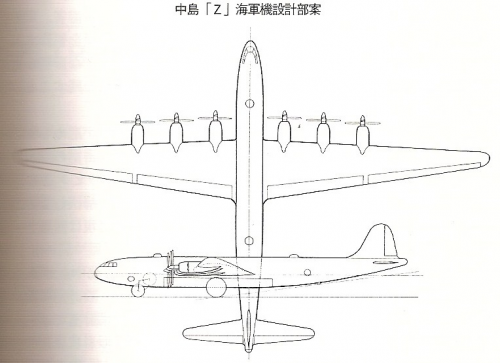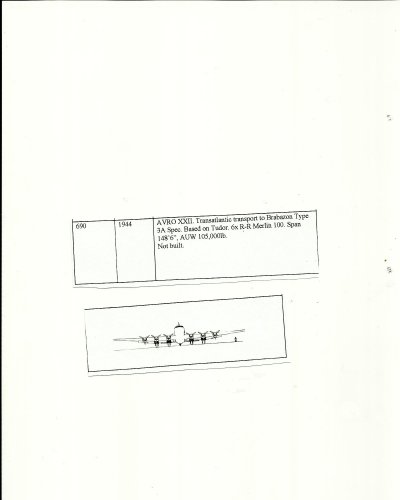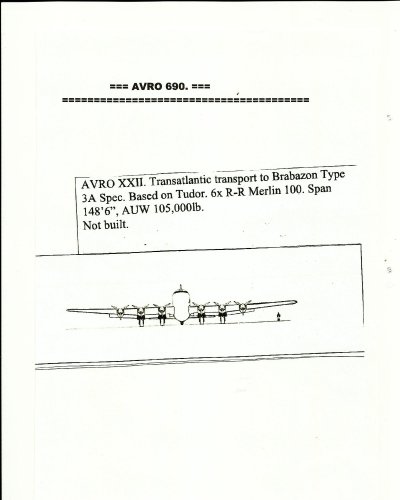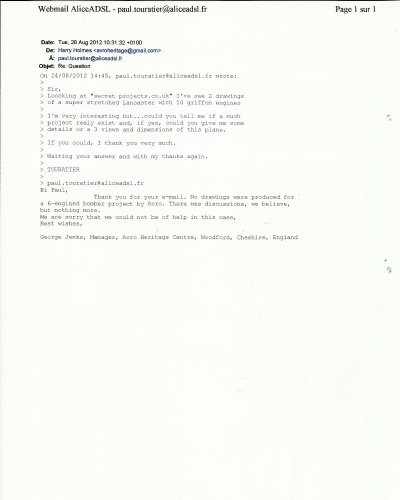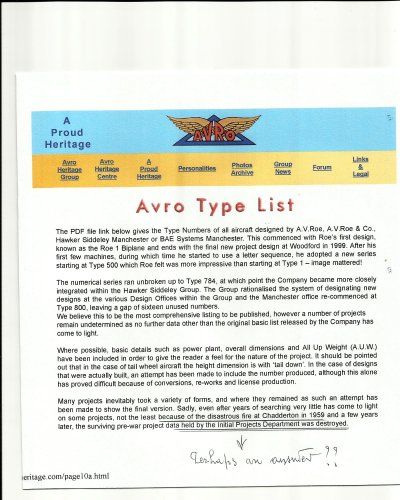You are using an out of date browser. It may not display this or other websites correctly.
You should upgrade or use an alternative browser.
You should upgrade or use an alternative browser.
Avro Super Heavy Bomber
- Thread starter Tzoli
- Start date
- Joined
- 11 March 2006
- Messages
- 8,640
- Reaction score
- 3,286
It's descrbied in Tony Buttlers BSP Fighters & Bombers 1935 - 1950, at least in short form:
It was the larger one of two designs with about 100 tons, based on the Lancaster, with ten
unspecified engines of 2.000 hp each. Range was 2.500 miles (4.023 km) with a fuel load
of 78.800 lbs (35.744 kg). This design seem to have fallen out of favour with the ministry,
as the fuselage was described as "unnecessarily large" !
It was the larger one of two designs with about 100 tons, based on the Lancaster, with ten
unspecified engines of 2.000 hp each. Range was 2.500 miles (4.023 km) with a fuel load
of 78.800 lbs (35.744 kg). This design seem to have fallen out of favour with the ministry,
as the fuselage was described as "unnecessarily large" !
- Joined
- 11 March 2006
- Messages
- 8,640
- Reaction score
- 3,286
Made a rough (very rough indeed !) estimation based on the assumption, that the spacing of
the engines would have been the same. Seemed quite logical to me, as they weren't much more powerful,
than the Lancasters Merlins, and this would allow using Lancaster jigs and maybe even the same props.
The distance from the 5th engine to the wingtip, I guesstimated from the painting (distance engine 4 to engine 5/
distance distance engine 5 to wingtip). So half span would be around 29,20 m, span 58,40m.
If it could have been built during the war, I don't know. Would have been possible to build 2.5 times as many
Lancasters with this number of engines !
the engines would have been the same. Seemed quite logical to me, as they weren't much more powerful,
than the Lancasters Merlins, and this would allow using Lancaster jigs and maybe even the same props.
The distance from the 5th engine to the wingtip, I guesstimated from the painting (distance engine 4 to engine 5/
distance distance engine 5 to wingtip). So half span would be around 29,20 m, span 58,40m.
If it could have been built during the war, I don't know. Would have been possible to build 2.5 times as many
Lancasters with this number of engines !
Attachments
pathology_doc
ACCESS: Top Secret
- Joined
- 6 June 2008
- Messages
- 1,456
- Reaction score
- 1,225
Jemiba said:Would have been possible to build 2.5 times as many
Lancasters with this number of engines !
Or to give each Lancaster a single-seat fighter escort!
Clearly the Brits had more important fish to fry and better things to be doing with their Merlins and Griffons, not to mention all that structural light-alloy. Unless of course you're operating at about 35,000ft and close to 300mph cruise, in which case a lot of fighters which might find the average Lancaster easy meat are going to struggle to nail one of these.
does anyone know of a source for ga drawings of this impressive design?
cheers, Joe
cheers, Joe
- Joined
- 11 March 2006
- Messages
- 8,640
- Reaction score
- 3,286
No, not for a decent one. I just tried to mix the two paintings with the a drawig of the Lincoln and my
estimated calculation. BTW, using the Lincoln as basis gave a slightly different span of 58,15m and a
length of 26,6m. The landing gear is just my interpretation of Tony Buttlers description in the BSP issue:
" The landing gaers had front and midship wheels of equal diameter". If someone has another idea, please
tell me, I'm open to discussion about this and other details.
estimated calculation. BTW, using the Lincoln as basis gave a slightly different span of 58,15m and a
length of 26,6m. The landing gear is just my interpretation of Tony Buttlers description in the BSP issue:
" The landing gaers had front and midship wheels of equal diameter". If someone has another idea, please
tell me, I'm open to discussion about this and other details.
Attachments
- Joined
- 13 August 2007
- Messages
- 7,469
- Reaction score
- 7,522
I reminded vaguely that Barnes Wallis proposed 1940 a big Bomb, what needed super Heavy Bomber.
But War ministry say NO, so Wallis start a new project in 1942: the Bouncing Bomb.
Could this Avro Super Heavy Bomber a real proposal, for transport Wallis big Bomb ?
But War ministry say NO, so Wallis start a new project in 1942: the Bouncing Bomb.
Could this Avro Super Heavy Bomber a real proposal, for transport Wallis big Bomb ?
- Joined
- 11 March 2006
- Messages
- 8,640
- Reaction score
- 3,286
According to Tony Buttlers BSP, for the bomb, which later became the "Tall Boy", Barnes Wallis had planned in 1940
a 50 ton bomber, that means, half the weight of the Avro and other later designs. Those designs were triggered
by a requirement in 1942 for a bomber with at least 15 ton, preferably 20ton bombload, carried over a range of 2.500 miles
with a cruising speed of 480 km/h, but at a reduced operating height of 6.000.m
a 50 ton bomber, that means, half the weight of the Avro and other later designs. Those designs were triggered
by a requirement in 1942 for a bomber with at least 15 ton, preferably 20ton bombload, carried over a range of 2.500 miles
with a cruising speed of 480 km/h, but at a reduced operating height of 6.000.m
- Joined
- 13 August 2007
- Messages
- 7,469
- Reaction score
- 7,522
3 to 4 time more bomb load as a Avro Lancaster or B-17 ?! 
Jesus, i try to imagine, how a whole fleet of these monster "Linebacker" the Third Reich flat out.
with this soundtrack in background... ;D
http://www.youtube.com/watch?v=gQ5-vPcfE-Y
Jesus, i try to imagine, how a whole fleet of these monster "Linebacker" the Third Reich flat out.
with this soundtrack in background... ;D
http://www.youtube.com/watch?v=gQ5-vPcfE-Y
- Joined
- 11 March 2006
- Messages
- 8,640
- Reaction score
- 3,286
Stargazer2006 said:Wonder if the proposed Miles "Libellula B.I" was related to the same tender. I always found it humongous!
Not explicitely mentioned in the BSP issue, but the bombload (23 ton !)would qualify it for this requirement.
blackkite
Don't laugh, don't cry, don't even curse, but.....
- Joined
- 31 May 2007
- Messages
- 8,390
- Reaction score
- 6,310
Thanks Jemiba. Great work!Jemiba said:No, not for a decent one. I just tried to mix the two paintings with the a drawig of the Lincoln and my
estimated calculation. BTW, using the Lincoln as basis gave a slightly different span of 58,15m and a
length of 26,6m. The landing gear is just my interpretation of Tony Buttlers description in the BSP issue:
" The landing gaers had front and midship wheels of equal diameter". If someone has another idea, please
tell me, I'm open to discussion about this and other details.
But I feel it’s rather hard to harmonize air center with center of gravity for such a arrangement.
Engines are heavy. Also landing gear is hard to design because of heavy weight. Wing root bending moment due to lift is very large, wing root design is hard,too. I think we need tapered wing to reduce wing root bending moment for such a aircraft. Perhaps wing area of this configulation is too large.
- Joined
- 11 March 2006
- Messages
- 8,640
- Reaction score
- 3,286
Well, you're probably quite right. Actually, still yet I left those thoughts apart and just
concentrated on trying on a 3-view based on those paintings. But I wouldn't be too surprised,
if they were made without such thoughts, too ! Would be good to know the sources used for
them, as I have the feeling it were descriptions only ! This design shows a remarkable similarity
to the Lincoln, which actually came later. But of course, maybe it was the other way round and the
Lincoln was a downsized version of this bomber and used.
But I'll try to reduce wing area by more taper.
concentrated on trying on a 3-view based on those paintings. But I wouldn't be too surprised,
if they were made without such thoughts, too ! Would be good to know the sources used for
them, as I have the feeling it were descriptions only ! This design shows a remarkable similarity
to the Lincoln, which actually came later. But of course, maybe it was the other way round and the
Lincoln was a downsized version of this bomber and used.
But I'll try to reduce wing area by more taper.
blackkite
Don't laugh, don't cry, don't even curse, but.....
- Joined
- 31 May 2007
- Messages
- 8,390
- Reaction score
- 6,310
Hi Jemiba!Jemiba said:It's descrbied in Tony Buttlers BSP Fighters & Bombers 1935 - 1950, at least in short form:
It was the larger one of two designs with about 100 tons, based on the Lancaster, with ten
unspecified engines of 2.000 hp each. Range was 2.500 miles (4.023 km) with a fuel load
of 78.800 lbs (35.744 kg). This design seem to have fallen out of favour with the ministry,
as the fuselage was described as "unnecessarily large" !
You can check wing loading and power loading using following data.
Gross weight was 100 ton.
Total power was 20.000hp.
How about using tapered wing with sweep back leading edge or you have proper position for air center and center of gravity.
And such a wing shape has inherent directional stability same as tailless aircraft, you can reduce vertical stabilizer area.
- Joined
- 11 March 2006
- Messages
- 8,640
- Reaction score
- 3,286
Hi blackkite,
tried to follow your advise, gave the wing greater leading edge sweep and taper and
reduced the vertical area somewhat. To deduce the CG is difficult, without reliable
knowledge of the length and depth of the bombay. But we are still within the shape given
by the paintings, at least of the one, that is close to a side view, I think.
tried to follow your advise, gave the wing greater leading edge sweep and taper and
reduced the vertical area somewhat. To deduce the CG is difficult, without reliable
knowledge of the length and depth of the bombay. But we are still within the shape given
by the paintings, at least of the one, that is close to a side view, I think.
Attachments
blackkite
Don't laugh, don't cry, don't even curse, but.....
- Joined
- 31 May 2007
- Messages
- 8,390
- Reaction score
- 6,310
Hi Jemiba!
Do you calculate wing area? Show us the wing loading value.
Please watch my image for this super heavy bomber wing shape except engines.
Strange?
B-36's nose is very long to adjust the position of air center and center of gravity, because her engines were located wing trailing edge.
Do you calculate wing area? Show us the wing loading value.
Please watch my image for this super heavy bomber wing shape except engines.
Strange?
B-36's nose is very long to adjust the position of air center and center of gravity, because her engines were located wing trailing edge.
Attachments
- Joined
- 11 March 2006
- Messages
- 8,640
- Reaction score
- 3,286
Huh ! Did the calculation ... but the result seems to be very high, in a region, that's usually only reached with
jet driven pax liners : 322,2 kg/sqm !
Have attached my calculation sheet, so, if you spot the error, please tell me (but please not my good old
teacher ! )
)
jet driven pax liners : 322,2 kg/sqm !
Have attached my calculation sheet, so, if you spot the error, please tell me (but please not my good old
teacher !
Attachments
- Joined
- 25 June 2009
- Messages
- 13,941
- Reaction score
- 3,574
Extremely nose heavy I guess... and I can imagine the heavy loads on the wing's longerons and it doesn't seem like a very viable design to me...
The Miles design had at least the merit of balancing out the weight over two sets of shorter wings.
The Miles design had at least the merit of balancing out the weight over two sets of shorter wings.
- Joined
- 13 August 2007
- Messages
- 7,469
- Reaction score
- 7,522
Nice work, Jemiba.
My only concern is that landing gear is to narrow, with the length of the wings.
try to take off and landing would be a nightmare on stability.
Is better to move the landing gear one engine pod farther outside or install second pair Landing gear further away.
with 15 ton or 33069 lbs. this is impressive payload:
1x Grand Slam bomb and 2767 incendiaries bomb 4 lbs
2x Tallboy and 2267 incendiaries bomb 4 lbs
4x Plumduff-Plus HC and 267 incendiaries bomb 4 lbs
8x Cookie HC and 267 incendiaries bomb 4 lbs
16x AP Bombs and 267 incendiaries bomb 4 lbs
33x GP/HE Bombs 1000 lbs
132x GP/HE bombs 250 lbs
the question is has this Monster a bomb-bay big enough to take this load ?
My only concern is that landing gear is to narrow, with the length of the wings.
try to take off and landing would be a nightmare on stability.
Is better to move the landing gear one engine pod farther outside or install second pair Landing gear further away.
with 15 ton or 33069 lbs. this is impressive payload:
1x Grand Slam bomb and 2767 incendiaries bomb 4 lbs
2x Tallboy and 2267 incendiaries bomb 4 lbs
4x Plumduff-Plus HC and 267 incendiaries bomb 4 lbs
8x Cookie HC and 267 incendiaries bomb 4 lbs
16x AP Bombs and 267 incendiaries bomb 4 lbs
33x GP/HE Bombs 1000 lbs
132x GP/HE bombs 250 lbs
the question is has this Monster a bomb-bay big enough to take this load ?
blackkite
Don't laugh, don't cry, don't even curse, but.....
- Joined
- 31 May 2007
- Messages
- 8,390
- Reaction score
- 6,310
Never mind. Fugaku was almost 600kg/sqm.Jemiba said:Huh ! Did the calculation ... but the result seems to be very high, in a region, that's usually only reached with
jet driven pax liners : 322,2 kg/sqm !
Have attached my calculation sheet, so, if you spot the error, please tell me (but please not my good old
teacher !)
blackkite
Don't laugh, don't cry, don't even curse, but.....
- Joined
- 31 May 2007
- Messages
- 8,390
- Reaction score
- 6,310
Hi Star! I think so,too. If this super heavy bomber's engines were located straight wing leading edge, nose must be very short and tail must be very long.Stargazer2006 said:Extremely nose heavy I guess... and I can imagine the heavy loads on the wing's longerons and it doesn't seem like a very viable design to me...
The Miles design had at least the merit of balancing out the weight over two sets of shorter wings.
- Joined
- 11 March 2006
- Messages
- 8,640
- Reaction score
- 3,286
About the viability I have some doubts, too. Nose heaviness would be somewhat bettered with the leading
edge sweep and I tried to improve the loads on the wing with another interpretation of the cryptical description
of the landing gear. Maybe one set of wheels on the inner engines and another set under the second pair, a little
bit further aft was meant ?
edge sweep and I tried to improve the loads on the wing with another interpretation of the cryptical description
of the landing gear. Maybe one set of wheels on the inner engines and another set under the second pair, a little
bit further aft was meant ?
Attachments
- Joined
- 13 August 2007
- Messages
- 7,469
- Reaction score
- 7,522
Jemiba said:About the viability I have some doubts, too. Nose heaviness would be somewhat bettered with the leading
edge sweep and I tried to improve the loads on the wing with another interpretation of the cryptical description
of the landing gear. Maybe one set of wheels on the inner engines and another set under the second pair, a little
bit further aft was meant ?
ja, ja, ja, ehh i mean yes ;D
blackkite
Don't laugh, don't cry, don't even curse, but.....
- Joined
- 31 May 2007
- Messages
- 8,390
- Reaction score
- 6,310
Hi Jens! Good design.Jemiba said:About the viability I have some doubts, too. Nose heaviness would be somewhat bettered with the leading
edge sweep and I tried to improve the loads on the wing with another interpretation of the cryptical description
of the landing gear. Maybe one set of wheels on the inner engines and another set under the second pair, a little
bit further aft was meant ?
Please watch my table for Fugaku specification again. B-36's wing loading was 420kg/sqm. I made a mistake in this table. Of course B-36's R-4360 engine had a turbocharger.
I apologize you that Fugaku's wing loading was 370kg/sqm. 600kg/sqm was Z-koizumi's value.
Attachments
- Joined
- 11 March 2006
- Messages
- 8,640
- Reaction score
- 3,286
Well, the negative effects of a high wing loading (high take-off/landing speeds, stall characteristics", can
of course be mellowed by high lift devices and a proper pilots training. Nevertheless, I had the problems
with the Martin B-26 Marauder in mind, which got the unwanted nickname "widowmaker" after several
crashes due to problems associated with its wing loading of about 280 kg/sqm (only !).
of course be mellowed by high lift devices and a proper pilots training. Nevertheless, I had the problems
with the Martin B-26 Marauder in mind, which got the unwanted nickname "widowmaker" after several
crashes due to problems associated with its wing loading of about 280 kg/sqm (only !).
blackkite
Don't laugh, don't cry, don't even curse, but.....
- Joined
- 31 May 2007
- Messages
- 8,390
- Reaction score
- 6,310
Hi! You need more large wing for this bomber?
I believe B-36 did not have such problems which B-26 experienced , nevertheless it's high wing loading (420kg/sqm).
You can include wing/fuselage intersection area in wing area calculation.
I believe B-36 did not have such problems which B-26 experienced , nevertheless it's high wing loading (420kg/sqm).
You can include wing/fuselage intersection area in wing area calculation.
- Joined
- 11 March 2006
- Messages
- 8,640
- Reaction score
- 3,286
Hello Paul, good find ,tried to have a look by myself, but I cannot open the list ...
What do you mean with double wheels ? The 690 seems to have the same type of
landing gear as the Lancaster or Lincoln, although without a side view it's not that
clear. In the third variant of the 10-engined bomber I tried to fit single wheels to the
inner and adjacent nacelles, with the latter just further aft, than the former.
What do you mean with double wheels ? The 690 seems to have the same type of
landing gear as the Lancaster or Lincoln, although without a side view it's not that
clear. In the third variant of the 10-engined bomber I tried to fit single wheels to the
inner and adjacent nacelles, with the latter just further aft, than the former.
blackkite
Don't laugh, don't cry, don't even curse, but.....
- Joined
- 31 May 2007
- Messages
- 8,390
- Reaction score
- 6,310
Hi! I thank you very much for your great effort.toura said:Hi all
I'm interesting by the 10 engined Avro bomber.
So, I ask to " avroheritage@gmail.com"
to have more details if possible....... here is the answer !!!!
But I think that there are no answer about 10 engine bomber in Avro heritage center's answer.
- Joined
- 11 March 2006
- Messages
- 8,640
- Reaction score
- 3,286
Paul, many thanks for your effort, an "oldfashioned" letter may sometimes be more effective, than
a "modern" email or a fax.
That it isn't known to the Avro Heritage could of course mean, that documents were destroyed in the meantime.
Nevertheless, Tony mentioned it in his BSP volume, so clues were actually somewhere. To my opinion, the problem
could (!) be, that it wasn't meant as "project" in common sense, that means, to be designed in a way, that would
have enabled Avro actually to build it. Looking at it more sceptical , the idea of an aircraft with 10 individual engines
could seem to be a little bit far fetched. Coupling of engines or using them to drive contraprops already was technical
already feasible during 1942, but fraught with a higher complexity. So maybe this design was just made as a way to
prove, that 10 individual engines with ten single props would result in an aircraft unnecessarily large, with the associated
problems like the difficulties to design a spar stiff, but still light enough and so on ? That probably could have been done
most easily by blowing up an existing design, and the end result wouldn't have been intended to be viable. So there wouldn't
have been the need to apply a type or design number and in the end, it's quite logical, that it would have been forgotten
fast.
I think, it was Roy Braybrook, who told a similar story in one of his columns in AirInternational, about a design, that should just
show, that two engines under the wings and another one in the tail is the worst layout for a three engined airliner, exactly the
type, that later emerged as the MDD DC 10 and Lockheed Tristar !
And remember, how much fuss there still is about the German H-44/H-45 design battleships ! And in most (serious) books, you
can read, that those designs were just made as a calculation, what ships would be the result of ever increasing gun calibres and
matched armour ... and that they couldn't be build in a conventional dock, not to mention the amount of raw materials needed.
a "modern" email or a fax.
That it isn't known to the Avro Heritage could of course mean, that documents were destroyed in the meantime.
Nevertheless, Tony mentioned it in his BSP volume, so clues were actually somewhere. To my opinion, the problem
could (!) be, that it wasn't meant as "project" in common sense, that means, to be designed in a way, that would
have enabled Avro actually to build it. Looking at it more sceptical , the idea of an aircraft with 10 individual engines
could seem to be a little bit far fetched. Coupling of engines or using them to drive contraprops already was technical
already feasible during 1942, but fraught with a higher complexity. So maybe this design was just made as a way to
prove, that 10 individual engines with ten single props would result in an aircraft unnecessarily large, with the associated
problems like the difficulties to design a spar stiff, but still light enough and so on ? That probably could have been done
most easily by blowing up an existing design, and the end result wouldn't have been intended to be viable. So there wouldn't
have been the need to apply a type or design number and in the end, it's quite logical, that it would have been forgotten
fast.
I think, it was Roy Braybrook, who told a similar story in one of his columns in AirInternational, about a design, that should just
show, that two engines under the wings and another one in the tail is the worst layout for a three engined airliner, exactly the
type, that later emerged as the MDD DC 10 and Lockheed Tristar !
And remember, how much fuss there still is about the German H-44/H-45 design battleships ! And in most (serious) books, you
can read, that those designs were just made as a calculation, what ships would be the result of ever increasing gun calibres and
matched armour ... and that they couldn't be build in a conventional dock, not to mention the amount of raw materials needed.
Similar threads
-
-
-
British B.1/39 Heavy Bomber Competition
- Started by blackkite
- Replies: 22
-
-



